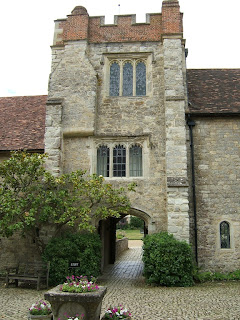It is a beautiful house in a secluded valley. Before modern roads it must have been hard to find and [in winter] hard to reach, despite being so close to London. There is a story that Cromwell's soldiers wanted to loot the place but could not find it, so they looted another house instead.
It has been owned by a number of families. The Hautes, the Selbys [who had it for three centuries], the Colyer-Fergusons and the American general who founded Colorado Springs. None of the British owners played any great part in national affairs.
When the house fell on hard times it was saved by an American called Charles Robinson. He bequeathed it to the National Trust.
When the house fell on hard times it was saved by an American called Charles Robinson. He bequeathed it to the National Trust.
To the left of the house the former stables and staff quarters have been converted into flats.
 |
| The Great Hall |
The small courtyard. You can see the Grade 1 listed dog kennel to the right. My earlier post on the dog kennel is here.
The house is the work of many hands. For example, the stone part of the tower is thought to date to date to the early 14th century, the stained glass windows to the early 16th century, the brick turret top to the late 19th century and the weathercock to the 1960s.
The house's valuable silver was kept in a safe in the butlers pantry.
The sink and draining board are covered in lead to reduce damage to valuable pottery and silverware.
 |
| The private chapel |
The First World War was particularly heavy on subalterns and the British aristocracy never recovered from its losses.
 |
| The housekeepers room |
I think Britain is fortunate to have an organisation like the NT, which is willing to spend a lot of money to preserve something like Ightham Mote and has the skills needed to do such a good job.
The house has over 70 rooms. Not all of them are open to the public. The ones that are closed are shaded on the plan below. There are more than enough rooms open and furnished to provide a superb experience.
Unlike Harvington Hall and Baddesley Clinton, Ightham Mote does not appear to have any hidden rooms [aka priest's holes]. You can find my post on Harvington Hall here and on Baddesley Clinton here.
This is my third post on Ightham Mote. My post on its giant dog kennel is here and a post on its porters squint is here.














No comments:
Post a Comment